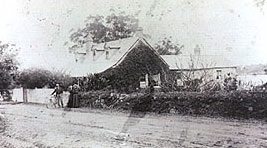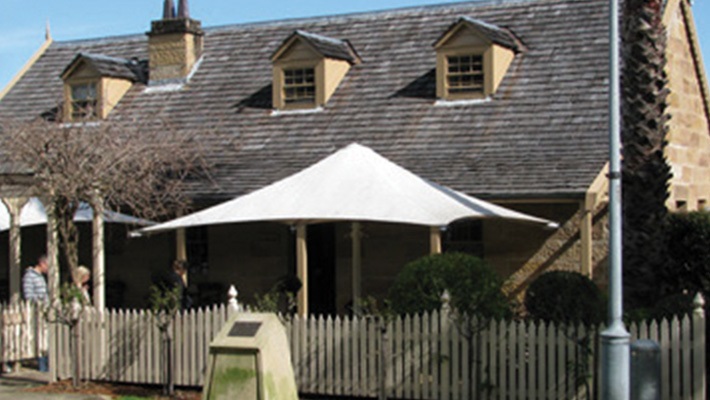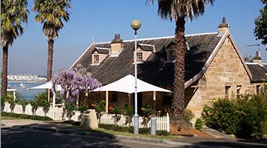Rockend Cottage
Located at: 40 Punt Road, Gladesville

Rockend is a nineteenth century sandstone cottage clinging to the edge of a rocky elevation above Looking Glass Bay and the Parramatta River near Bedlam Point at Gladesville. It is a single storey building with a large attic and two additional wings, and is built in a style which architectural historians refer to as 'Victorian Georgian'. The cottage is located within Banjo Paterson Park, one of Sydney Harbour's foreshore parks. It has a frontage to Punt Road which comes to an end a little below Rockend, with a scrambling track leading down to the sandstone remains of an old wharf at Bedlam Point.
The Great North Road
Today the pleasures of the park and the river are a world away from the traffic and noise of Victoria Road at the top of the street. But in the mid-nineteenth century, when Rockend was built, Punt Road was part of the Great North Road, one of the main routes leading north from Sydney to Newcastle. Part of the historical significance of Rockend lies in its relationship to the Great North Road. Travellers using this route journeyed out from Sydney along the Parramatta Road as far as Five Dock then turned onto the Great North Road leading to the waterside at Abbotsford, where a punt took them across the river to Bedlam Point. From here the road climbed up the hill to a government flagstaff (located more or less on the site of today's Gladesville Post Office) and continued north-west, running along the line of today's Victoria Road to St Anne's Church at Ryde. Above St Anne's the road turned north to Pennant Hills and on to Newcastle.
The Bedlam punt began operating in 1832 and the first house built on the Gladesville side of the new road was probably the puntman's cottage. According to one contemporary observer, this was a "small, two roomed, rough-cast and lathe building", standing on a rock overlooking the river and the punt landing places.
Then, in 1837, the colonial government established the "Tarban Creek Lunatic Asylum" east of Bedlam Point. By 1841 the asylum's first superintendent, J T Digby, had built himself a "beautiful Italian villa edifice" fronting the Great North Road, near the entrance to the asylum. By this time also an inn called the Red House had been opened on the Abbotsford side of the river to cater for travellers on the Great North Road.
In 1841 an attempt was made to subdivide the land around Looking Glass Bay into the "Village of Battersea". The attempt failed and it was not until November 1855 that the land was successfully subdivided, this time as the Gladesville Estate. Lots ranged in size from one to three acres and were promoted as suitable sites for "gentlemen's villas", with ample ground for gardens, lawns and orchards. Lot 47 of this estate, with a water frontage to Looking Glass Bay and a back frontage to the Bedlam Ferry Road, was sold to a Limerick-born master builder named John Crotty. It was on this lot that Rockend was built.
Construction
John Crotty, who also bought other land up the hill near the flagstaff, was probably the builder of Rockend and its first occupant. When he died in July 1859, leaving a widow and two sons, his death notice in the Sydney Morning Herald observed that he was "a master builder, of considerable eminence". He may have been involved in the construction of St Charles' church and his burial place in the churchyard there is marked by a finely carved headstone. By 1861 John Crotty's heirs were in financial difficulties and forced to sell their Gladesville property. An auction notice in August 1861 described the building on lot 47 as "a substantial stone-built family residence, containing seven rooms and kitchen".

Lot 47 was bought by a gentleman named Edward Craig Corner who lived in the house with his young family for only a few years before he too was forced by financial difficulties to sell the property. An auction notice for "Corner's property" in January 1864 described it as "a substantially built stone residence, containing verandah, hall, seven rooms, with large attic above, kitchen and cellar, yard, with water reservoir at the rear, and flower garden in front". The rest of the land was "laid out as orangery and orchard, just coming into bearing" and there was "a bathing house at the waterside."
In 1866, lot 47 became the property of Emily Mary Barton, a recently-widowed member of one of nineteenth-century Ryde's leading gentry families, the Darvalls. It was Emily Mary who gave the name Rockend to the cottage and it remained her home for more than 40 years. This association of the cottage with her, and with later generations of her family, is central to the historical significance of Rockend.
The Barton Family
When Emily Mary Barton took up residence at Rockend, her household included various unmarried children. Within a few years the cottage also became home to her widowed daughter Emily Paterson and Emily's children. In 1889 another widowed daughter, Rose Paterson, also sought shelter at Rockend with her youngest children. Rose's eldest son, Andrew Barton (Banjo) Paterson, had been a resident at Rockend in the 1870s while he attended Sydney Grammar School.
Visitors to Rockend were able to enjoy not only the outdoor pleasures of boating, bathing and fishing, but also the indoor pursuits of music, painting and poetry. Emily Mary Barton was a poet and published several prize-winning poems in the Sydney press in the 1880s. Her daughter Emily Paterson painted watercolours of Australian flowers and butterflies and exhibited in the Sydney International Exhibition in 1879. Emily Paterson's daughter, another Emily, composed music. Emily Paterson jnr also took an interest in some of the women patients at the asylum, sometimes inviting them over for croquet and tea on the lawn at Rockend. She later went on to establish the After Care Association to assist these women as they were discharged from the hospital. Her uncle, Henry Francis Barton, was Master in Lunacy and Master in Equity at the asylum.
Rockend Cottage 2002

Emily Mary Barton died at Rockend in 1909, at the age of 92. After her death, the house had various tenants and owners until it was purchased in 1923 by Harold Meggitt, who established a linseed oil extraction plant on what had become by that time a 5-acre site. The cottage was converted into an office for the factory. When the plant closed in 1974 it was in a bad state of repair but was saved from demolition by a community campaign which also led to the acquisition of the site by the State Government for community use as foreshore parkland. Currently the cottage is leased as the Banjo Paterson Cottage Restaurant.
Current Condition
Rockend Cottage is in good condition and presents well, however, to project its longevity it requires a progressive program of works over the short and medium term to maintain the structure back in its restored state. The building was initially the subject of an extensive restoration in the 1980s. Works required to maintain the building's good standard include internal tasks such as general painting and inspection together with external works such as replacement of the roof covering, reconstruction of some additions, monitoring and, as required, eradication of pests and reconstruction of several building elements. Works required within the building's curtilage include the reconstruction of the building's garden and some perimeter fencing together with general maintenance.
Completion of these tasks, together with the institution of a conservative works program will maintain the building in its current good state.
Written by Megan Martin, Local Studies Librarian, Ryde Library & Information Services. April 1997.